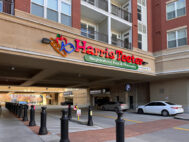Harris Teeter to lay off 91 Fairfax County employees
Harris Teeter will permanently close a fulfillment center in Fairfax County on Feb. 1, 2026, laying off 91 employees.
Touhill leaving Arlington Economic Development
Arlington Economic Development Director Ryan Touhill is leaving AED, the Arlington Chamber of Commerce confirmed Thursday.
Dataminr to buy Arlington cybersecurity firm for $290M
Dataminr announced Tuesday it plans to acquire Arlington County-based cybersecurity firm ThreatConnect in a deal valued at $290 million.
Redhorse taps new CEO
Arlington County-based federal contractor Redhorse announced this week that it is promoting President Noah Klemm to CEO.
RTX subsidiary hit by major cyberattack
A major ransomware against an RTX subsidiary disrupted check-in and boarding systems at several airports across Europe over the weekend
Boeing wins $883M Army cargo support contract
Boeing has been awarded a $883.1 million contract from the U.S. Army to provide cargo engineering and logistics support services.
Housing sales decline in NoVa, Hampton Roads
Housing sales last month decreased year-over-year in Northern Virginia and Hampton Roads, although inventory and median sales prices rose.
RTX subsidiary secures $580M Navy contract
Raytheon, a subsidiary of Arlington County-based Fortune 500 aerospace and defense contractor RTX, has received a $580.58 million U.S. Navy contract, the Defense Department announced May 15.
New Arlington hub to boost defense, energy startups
Virtus Innovation Center in Arlington will support 30+ startups in defense and energy, connecting them to talent, capital, and federal customers.
Level Access appoints chief customer experience officer
Arlington-based software company Level Access announced this week that it has appointed Andrew Snyder to be its chief customer experience officer.
AeroVironment completes $4.1B acqusition of BlueHalo
Arlington County-based defense contractor AeroVironment on Thursday announced that it had successfully completed its $4.1 billion acquisition of Arlington aerospace and defense tech firm BlueHalo.
VHC Health announces new foundation president
Amy Ellis Hauser will be the next president of the VHC Health Foundation and senior vice president of VHC Health, the Arlington County health system announced this week. VHC Health is a not-for-profit, 537-bed health system serving the Washington, D.C., metropolitan area. The new role is a return for Hauser, who previously held key positions […]























